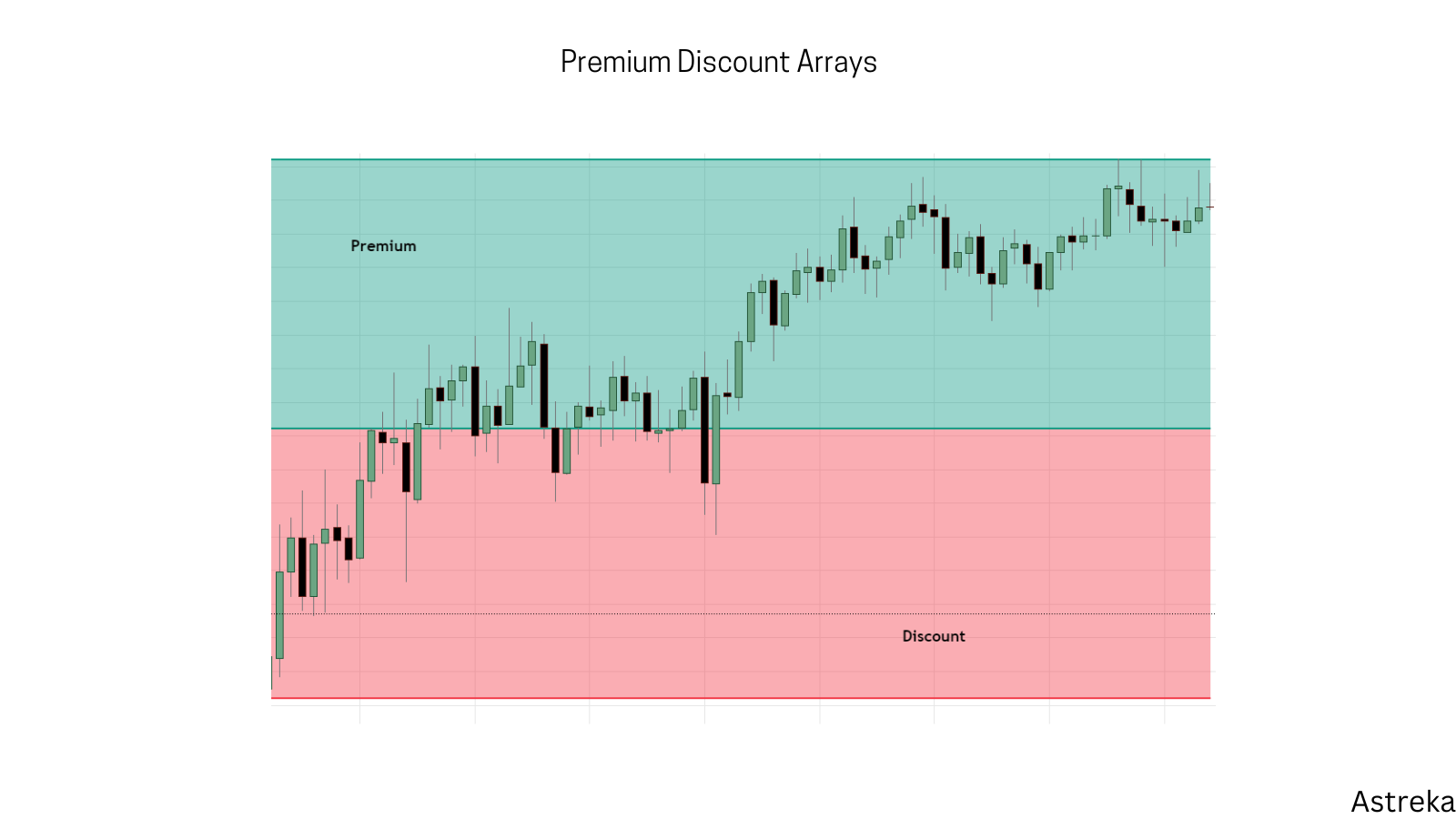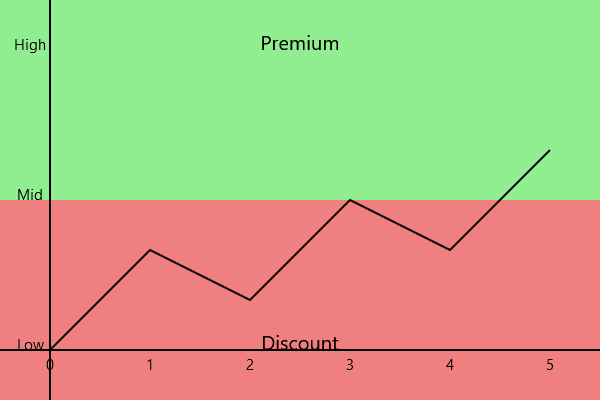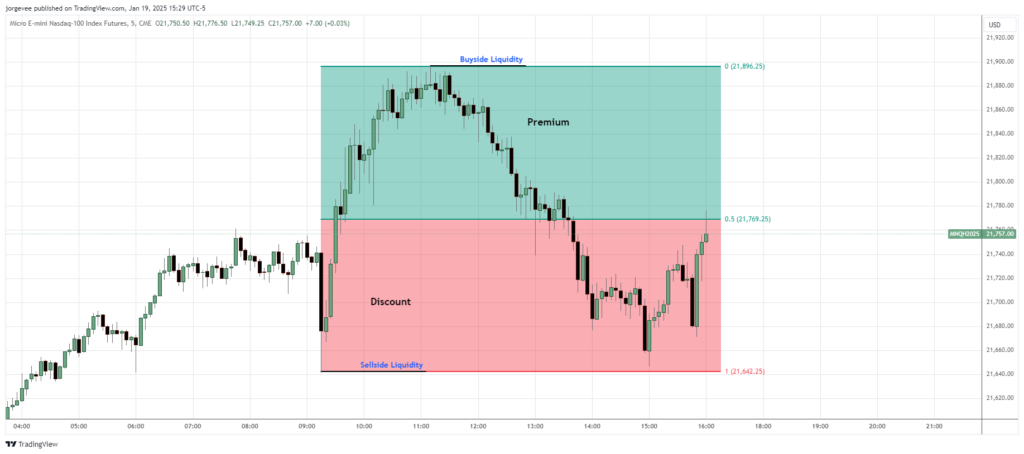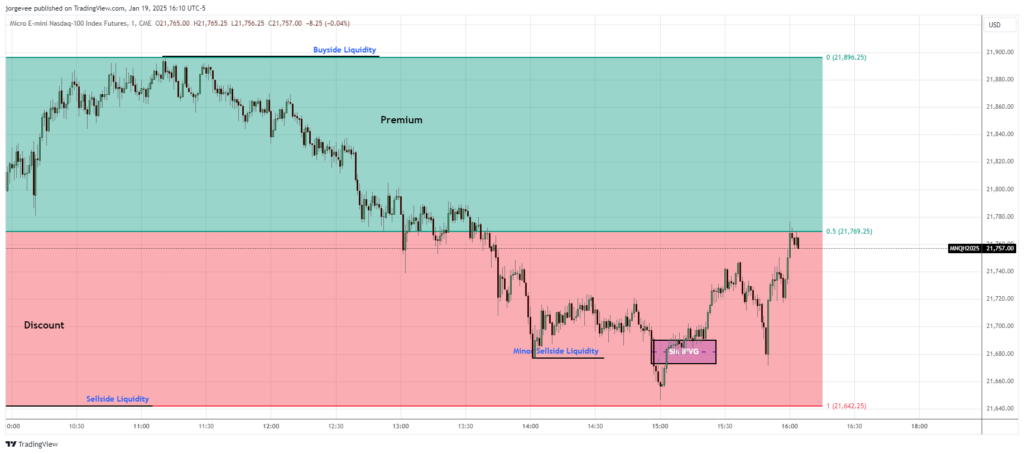
January 19, 2025
Decoding Market Entry Points: A Guide to ICT PD Arrays
The market is not random; it’s driven by large players often referred to as “smart money.” Understanding their motives and actions is crucial for successful trading. But how do you decipher their moves? This is where ICT PD Arrays come into play. They provide a structured approach to identifying areas where smart money is likely to accumulate or distribute, giving you a significant edge in your trading. Discover how you can use this knowledge to time entries better, boost win rates, and minimize risks.
Understanding the Core: Premium and Discount Zones

What is a Dealing Range?
The ICT Dealing Range is essentially a defined price range within which market activity is focused. It’s identified by a significant high and a significant low on a price chart, establishing the boundaries of price movement. This range serves as the foundational structure for identifying premium and discount areas, which are crucial for finding optimal trading opportunities. Think of it as the playing field where “smart money” operates, and where we seek to find our edge.
The Fibonacci Connection
To pinpoint the premium and discount areas within a Dealing Range, we employ a specific application of the Fibonacci retracement tool. We plot the Fibonacci from a clearly established high to an established low, using the following levels: 1 at the high, 0 at the low, and most importantly, 0.5 at the middle. This 0.5 level, also known as the 50% retracement, serves as the equilibrium point. It’s the “line of demarcation” that separates the premium zone from the discount zone.
Defining Premium and Discount
Now that we have our Fibonacci levels, we can define our trading zones. Areas above the 0.5 Fibonacci level are considered the premium zone. This is where we want to look for opportunities to sell. Conversely, areas below the 0.5 level constitute the discount zone, where we are primarily seeking to buy.

The underlying logic is simple: as a seller, you want to sell at a premium price, and as a buyer, you naturally want to buy at a discounted price. By aligning our trades within these zones, we are essentially positioning ourselves in line with the way “smart money” strategically accumulates and distributes assets.
As you can see in figure 1, the area highlighted in green is the premium zone, and the area highlighted in red is the discount zone. This particular chart shows the price breaking market structure to the downside, and then rallying up into the premium zone (in green). The intention with a bearish daily bias would be to find any bearish pd arrays in the premium zone.
- If your bias was bearish, you would be focusing on looking at the premium zone for possible entries. You will see that in this example the price is trading in the premium zone after a market structure shift to the downside.
- If your bias was bullish, you would instead be focusing on looking for bullish PD Arrays (like the ones we’ll cover) within the discount zone to initiate buying positions.
This practical view should make the concept of bullish and bearish PD Arrays much clearer, providing a real-world visualization of where we should be looking to align our trades
Exploring Bullish and Bearish PD Arrays
PD Array Types
Within the framework of the premium and discount zones, we distinguish between two primary types of PD arrays: Bullish and Bearish. These are not inherently “good” or “bad,” rather, they are simply tools that are defined by their location relative to the 0.5 Fibonacci level on a dealing range. Bullish PD arrays signal potential buying opportunities, while Bearish PD arrays point to areas where selling might be advantageous. Understanding their specific makeup and function is essential for effective application.
Bullish & Bearish PD Arrays (Trading Opportunities)
Bullish PD arrays are the collection of ICT tools and concepts found specifically within the discount zone. These tools and concepts act as potential catalysts for a bullish price movement. When you identify these setups within the discount zone, and your overall bias is bullish, you can begin to look for buying opportunities. Here’s a list of the most relevant:
- Fair Value Gap (BISI/SIBI): A price imbalance, represented by a gap where the current candle’s high does not overlap with the lows or highs of the previous two candles (where selling might become weak).
- Order Block: An order block is a down-closed candle (typically) before an impulsive bullish move, often acting as a key level.
- Breaker Block: A failed bearish/bullish order block, subsequently broken by price, transforming into a potential support/resistance area.
- Inverse Fair Value Gap (iFVG): When a Fair Value Gap is violated, this area can act as an area where price could reject (a form of support).
- ICT New Day Opening Gap (NDOG): A price gap that can be used as a support/resistance when price retraces back to its level.
- ICT New Week Opening Gap (NWOG): Similar to NDOG, another price gap that can be used as a support/resistance when price retraces back to its level.
- ICT Unicorn Model: A complex structure involving a Fair Value Gap, an Order Block, and a Breakout, often seen as a high-probability buy setup.

It’s crucial to remember that bullish PD Arrays, found in the discount zone, help you to identify potential areas to initiate buying positions. They are designed to help you to find optimal prices where a market trend is likely to move in your favor.
In Figure 2 scenario, you can observe how price initially breaks structure to the downside, rallies up into the premium zone, and then trades lower to take out a minor low. After that, the price action moves back up and it reclaims the low that it just took. You can see how the price trades through the Minor Sellside Liquidity, and it created an iFVG in the discount area, highlighted in the purple box.
- This iFVG in the discount area would act as an entry. This is an example of a bullish pd array
It is important to note how these tools and concepts are not meant to be traded on their own, but are designed to give you areas where you can get better probability of success. In this example, you will notice there are multiple tools that were present in this range and can act as confluence.VI. Final Thoughts and Important Considerations
Final Thoughts and Important Considerations
Finding the “Better” Price
The power of ICT PD Arrays lies in their ability to help you identify superior entry points. By focusing on premium and discount zones, and utilizing the defined PD array tools, you’re not just entering trades randomly. Instead, you’re positioning yourself to buy when prices are relatively low (discount) and sell when they’re relatively high (premium), significantly improving the probability of a favorable outcome. This approach aligns with the core principle of successful trading: buy low, sell high.
Synergy with Other ICT Concepts
While PD arrays are a potent tool on their own, they truly shine when combined with other ICT trading methodologies. Concepts like market structure, liquidity sweeps, and specific ICT models can all work together to create a robust trading approach. Think of PD arrays as a foundation – one that’s greatly strengthened by the addition of other insightful ideas.
Risk Management: The Cornerstone of Trading
Remember, there are no guaranteed strategies in trading. The market is dynamic and unpredictable, and any single tool or technique must always be used with caution. This is why risk management is absolutely critical for long-term success.
- Stop-Loss Orders: Always, without exception, use stop-loss orders to limit your potential losses. This isn’t an optional extra; it’s a mandatory component of responsible trading.
- Prudent Capital Management: Risk only a small portion of your trading capital on each trade. Don’t allow emotions to drive your decisions, and trade at levels where you would be comfortable with a potential loss. Consistent and thoughtful risk management protects your capital and keeps you in the game for the long haul.
Conclusion
ICT PD Arrays provide a robust framework for identifying high-probability trade entry points. By focusing on premium and discount zones and the associated tools, you can find optimal places to initiate both buying and selling positions. The advantage of PD arrays lies in their potential to improve your timing and overall consistency.
However, mastery requires dedicated effort, practice, and a commitment to continuous learning. Don’t expect overnight success. Hone your understanding of PD Arrays and their synergy with other ICT methodologies, and you’ll be well on your way to becoming a more proficient and confident trader. Remember that practice is the key to mastery.